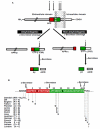Phosphorylation of amyloid beta (Aβ) peptides - a trigger for formation of toxic aggregates in Alzheimer's disease
- PMID: 21869458
- PMCID: PMC3184981
- DOI: 10.18632/aging.100362
Phosphorylation of amyloid beta (Aβ) peptides - a trigger for formation of toxic aggregates in Alzheimer's disease
Abstract
Alzheimer's disease (AD) is the most common form of dementia and associated with the progressive accumulation of amyloid β-peptides (Aβ) in form of extracellular amyloid plaques in the human brain. A critical role of Aβ in the pathogenesis of AD is strongly supported by gene mutations that cause early-onset familial forms of the disease. Such mutations have been identified in the APP gene itself and in presenilin 1 and 2. Importantly, all the identified mutations commonly lead to early deposition of extracellular plaques likely by increasing the generation and/or aggregation of Aβ. However, such mutations are very rare and molecular mechanisms that might trigger aggregation and deposition of Aβ, in the most common late onset AD are largely unknown. We recently demonstrated that extracellular Aβ undergoes phosphorylation by a cell surface-localized or secreted form of protein kinase A. The phosphorylation of serine residue 8 promotes aggregation by stabilization of β-sheet conformation of Aβ and increased formation of oligomeric Aβ aggregates that represent nuclei for fibrillization. Phosphorylated Aβ was detected in the brains of transgenic mice and human AD brains and showed increased toxicity in Drosophila models as compared with non-phosphorylated Aβ. Together, these findings demonstrate a novel molecular mechanism that triggers aggregation and toxicity of Aβ. Thus, phosphorylation of Aβ could be relevant in the pathogenesis of late onset AD. The identification of extracellular protein kinase A should also stimulate pharmacological approaches to decrease Aβ phosphorylation in the therapy and/or prevention of AD.
Conflict of interest statement
The authors of this manuscript have no conflict of interest to declare.
Figures


References
Publication types
MeSH terms
Substances
LinkOut - more resources
Full Text Sources
Other Literature Sources
Medical
Molecular Biology Databases

